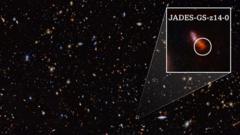
image source, NASA/ESA/CSA/STSCI/BRANT Robertson et al
- author, Jonathan Amos
- stock, Science Correspondent, BBC
The James Webb Space Telescope broke its own record by discovering the most distant galaxy ever known.
Called JADES-GS-z14-0, the star cluster was observed 290 million years after the Big Bang.
In other words, if the universe is 13 billion years old, we are observing the galaxy when the universe was only 2% of its current age.
Webb used his 6.5-meter primary mirror and sensitive infrared instruments to make the discovery.
The most interesting aspects of the most recent observation are not the distances in question – however implausible – but the astronomers' comments. The size and brilliance of JADES-GS-z14-0.
Webb measured the galaxy over 1,600 light years from end to end. Many of the most luminous galaxies produce most of their light from gas collapsing into a supergiant black hole.
But the JADES-GS-z14-0 criterion indicates that it is not the explanation in this case. However, researchers believe The light is produced by young stars.
“This massive amount of starlight represents a galaxy several hundred million times more massive than the Sun! It begs the question: How could nature have produced such a luminous, massive, and massive galaxy within 300 million years?”, Webb revealed. Astronomers Stefano Carniani and Kevin Heinlein.
Carniani is affiliated with the Scuola Normale Superiore in Pisa, Italy, and Heinlein with the University of Arizona in Tucson (USA).

The $10 billion James Webb Space Telescope (JWST) was launched in 2021 as a joint venture between the US, European and Canadian space agencies.
It is specially designed Explore the universe more deeply and see further through time than any other astronomical instrument.
One of its main objectives is to find the first stars that exploded during the birth of the universe.
These gigantic objects, perhaps hundreds of times larger than our Sun, are composed only of hydrogen and helium.
They are thought to have lived bright but brief burning lives, creating within their atomic centers the largest chemical elements known in nature today.
A significant amount of oxygen can be found in Webb JADES-GS-z14-0, this tells the researchers The galaxy is already very mature.
“The presence of oxygen early in the life of this galaxy is surprising and suggests that several generations of very massive stars have already ended their lives before we observe the galaxy,” Carniani and Heinlein added.

The acronym JADES in the object name stands for “JWST Advanced Deep Extragalactic Survey” in English.
It is one of several observing projects using the telescope to study the first few hundred million years of the universe.
“z14” stands for “redshift 14”. red shift A term used by astronomers to describe distance.
This is basically a measure of how much light emitted from a distant galaxy has been stretched into longer wavelengths by the expansion of the universe.
The greater the distance, the greater the extension.
The light from the first galaxies extended from ultraviolet and visible waves to infrared waves, a part of the electromagnetic spectrum to which James Webb's mirrors and instruments were specially tuned.
“If this galaxy was 10 times fainter, we would have been able to find it, which means we could see examples even earlier in the universe – probably in the first 200 million years,” said Professor Brandt Robertson of the University of California, Santana. Cross.
The discovery of JADES and its implications are described in a series of special papers published on Cornell University's arXiv preprint service, which you can read in English. Here.

Remember that you can receive notifications on our app. Download the latest version and activate them.
Eden Hayes
"Wannabe gamer. Subtly charming beer buff. General pop culture trailblazer. Incurable thinker. Certified analyst."





